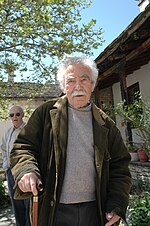Pavlos Vrellis Greek History Museum
The Pavlos Vrellis Greek History Museum (Greek: Μουσείο Ελληνικής Ιστορίας Παύλου Βρέλλη) also known as Pavlos Vrellis Museum of Wax Effigies is a privately owned wax museum in Ioannina regional unit, Greece. It was set up by the sculptor Pavlos Vrellis in February 1983, and is the best known wax museum in Greece.[1] The museum hosts 150 wax models in 37 themes, inspired by various events from Greek history.
 | |
 | |
| Location | |
|---|---|
| Coordinates | 39°19′54″N 20°31′20″E / 39.3318°N 20.5222°E |
| Type | Wax museum |
| Website | http://www.vrellis.org/ |

Location and history
editThe Museum's main building is located 14 km (9 mi) south of the city of Ioannina, Epirus, in Bizani municipality, on the Ioannina – Athens national road.[2] It was owned by local sculptor Pavlos Vrellis, who founded the museum in February 1983.[3] The museum facility covers an area of 2,500 m2 (2,990 sq yd) and is built according to the traditional, local, fortress-type architectural style of 18th-century, according to Vrellis' own design.[1][4]
A small annex with free access is located at Ioannina, 15 Karamanli street.[5]
Exhibits
editThe wax effigies of the museum are displayed in life size, included in a faithful representation of the environment of their age and revive forms of the local history. Without storeys but on a variety of distinct parallel and connecting levels. The visitor moves along mountains, houses, caves, churches, and alleys, following a non-circular but endless course, ingeniously devised and arranged.
They cover twenty four centuries of Greek history (from 500 BC), with an emphasis on the modern history of Epirus.[5][6] The museum hosts 37 themes and 150 wax models which represent various historical events.[4] There are three thematic units in the Museum: pre 1821 history, Greek War of Independence (1821-1830) and themes from World War II:[2][7]
- Secret Greek School during Ottoman rule.
- Foundation of Filiki Eteria
- Torture of Dionysius the Philosopher
- Klephts
- Death of Ali Pasha
- Theodoros Kolokotronis
- Women of Pindus (during the Battle of Pindus)
Moreover, specific themes are inspired from Jewish history, like images from The Holocaust[8]
References
edit- ^ a b Greek News Agenda. "Wax Museums in Greece". Secretariat General of Communication - Secretariat General of Information. Archived from the original on March 10, 2010. Retrieved 2010-04-07.
- ^ a b Ioannina.uoi.gr. Wax works by Pavlos Vrellis. University of Ioannina.
- ^ Schneider Lambert, Höcker Christoph (2003). Griechisches Festland: Antike und Byzanz, Islam und Klassizismus zwischen Korinthischem Golf und nordgriechischem Bergland (in German). DuMont Reiseverlag. p. 251. ISBN 978-3-7701-2936-2.
- ^ a b Pavlos Vrellis Museum of Greek History, Greece. Archived 2011-07-10 at the Wayback Machine europe-greece.com
- ^ a b Paul Hellander, Kate Armstrong (2006). Greece. Lonely Planet. p. 278. ISBN 978-1-74059-750-0.
- ^ Rockwood Caragh.Fodor's Greece. Fodor's, 1997. ISBN 978-0-679-03227-4, p. 152.
- ^ Prefectural Committee of Tourist Promotion. "Prefecture of Ioannina, Epirus-Greece" (PDF). Prefecture of Ioannina. Archived from the original (PDF) on November 28, 2006. Retrieved 2009-11-02.
- ^ Bötig Klaus (2008). Griechenland-DuMont Richtig reisen (in German). DuMont Reiseverlag. p. 124. ISBN 978-3-7701-7608-3.